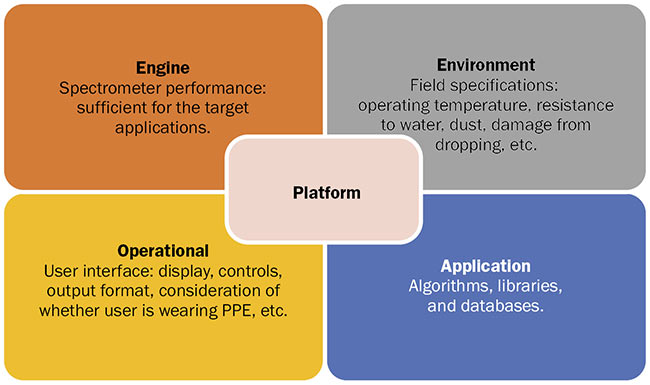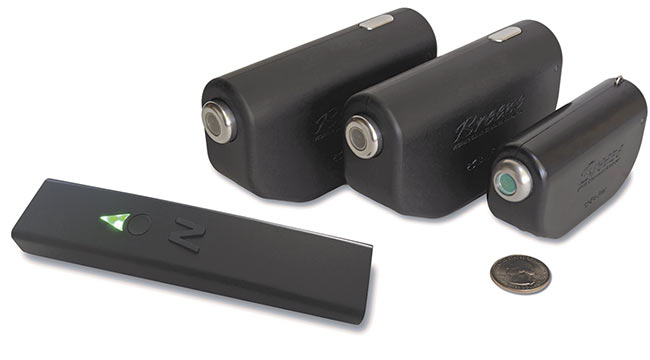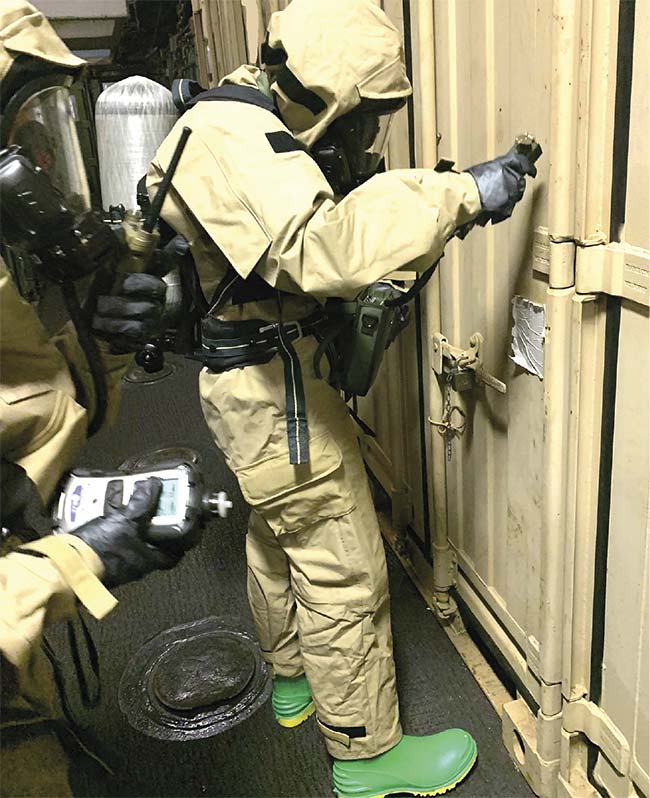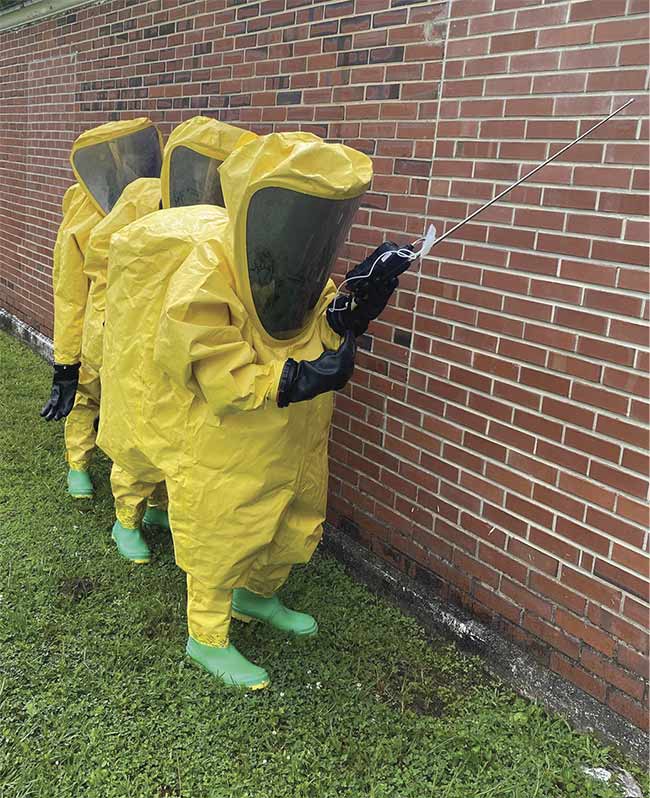Portable designs are carrying spectroscopy beyond the lab to deliver analytical capabilities directly to the sample in applications from forensics to cultural heritage.
RICHARD A. CROCOMBE, CROCOMBE SPECTROSCOPY CONSULTING; PAULINE E. LEARY, FEDERAL RESOURCES; AND BROOKE W. KAMMRATH, HENRY C. LEE INSTITUTE OF FORENSIC SCIENCE
Portable spectroscopic instruments have dramatically expanded their capabilities and detection limits over the past 20 years, while becoming smaller, lighter, and faster.
The examples of this today are legion. Portable laser-induced breakdown spectroscopy instruments now enable the critical measurement of carbon in steel, with a detection limit of 100 parts per million. Devices measuring a single cubic inch are available for near-infrared (NIR) and Raman spectroscopy. Portable instruments implementing more than one technique have become a reality, with at least two visible-NIR instruments on the market that each span roughly 400 to 1700 nm. Smartphone-based spectrometers are being deployed for clinical applications in the field, while consumer goods are embedding the technology. Hand-portable hyperspectral imaging instruments are also becoming increasingly possible.
Modern portable spectrometers can fit in the palm of the hand and are typically designed and engineered to minimize size, weight, and power profiles, which is critical to the continued success of portable spectroscopy.
Real-world ready
It is important to recognize two things about the growing field of mobile spectroscopy. First, the spectrometer engine is only one component of a successful portable spectroscopy platform. Second, today’s operators are unlikely to be scientists working within a controlled laboratory setting, and they will seek fast actionable information, not spectra, at (occasionally dangerous) sample sites.

A successful portable spectroscopy platform is more than a spectrometer engine. The design team must also consider the instrument’s intended operating environment and whether the user will be wearing personal protective equipment (PPE). The algorithm, database, and calibration required to process one or more spectra into results are critical because the operator is unlikely to be a scientist. Courtesy of Crocombe Spectroscopic Consulting.

Portable spectroscopic instruments that implement more than one technique have become a reality, with at least two visible-to-NIR instruments on the market that each span roughly 400 to 1700 nm. These palm-size spectrometers are controlled via a smartphone. Courtesy of BaySpec.
A successful portable platform, therefore, will integrate an optimized spectroscopic engine designed for target applications, and such a platform will be capable of performing well in challenging operational and environmental conditions. Applications that effectively integrate algorithms, libraries, and databases improve the system’s ability to translate spectral data into actionable information, while both operational and environmental considerations typically determine the field-friendliness of the spectrometer. The platform also needs to provide reliable results because erroneous information may lead to catastrophes ranging from incorrect handling of a chemical spill or threat to corrosion and eventual rupture of pipes in a petrochemical plant.
Attentive development of a solid spectroscopy platform can often take into account unmet market needs and support further applications development by the manufacturer, with new or amended databases, algorithms, and calibrations. New markets can then be found after the platform’s deployment. Prospective customers may even provide access to samples of interest, which also helps to optimize systems for a specific market or industry.
Such collaborations have fed a virtuous development cycle for portable x-ray fluorescence and Raman instruments by greatly expanding their software functionality and usage. End user requirements have often driven the development of spectroscopy instrumentation and its initial applications. Then, following commercialization, the available instrumentation has driven the development of additional applications. This iterative pattern of development is not limited to mobile spectroscopy. It has also fueled the evolution of hyperspectral imaging systems operating in the visible and shortwave NIR, helping to drive down the size, weight, power, and cost of these instruments, enabling hand-held designs, and facilitating integration with unmanned aerial vehicles.
The ability to perform spectroscopic analyses at the sample site has contributed to the success of many portable spectroscopy platforms — for example, systems designed to detect chemical warfare agents on the battlefield. The development of portable ion-mobility spectrometry platforms to support military applications began in the 1970s and remains critical today, as evidenced by the recent IDIQ (indefinite delivery/indefinite quantity) award granted by the U.S. Department of Defense to support development of the Solid Liquid Adapter (SLA) for the Joint Chemical Agent Detector (JCAD).


Chemical, biological, radiological, and nuclear defense specialists of the U.S. Marine Corps 2nd Marine Logistics Group and 22nd Marine Expeditionary Unit perform threat assessments using portable spectrometers while wearing bulky PPE. Such applications and user requirements pose important considerations when designing portable spectrometer instruments. Courtesy of Jake Herr.
The JCAD, the production of which began in 2011, was initially optimized to detect chemical warfare agents and toxic industrial chemicals, and it is intended to support the various mission requirements of the Joint Forces. When fitted with an SLA, the JCAD becomes an interesting portable spectroscopy platform because it retains its critical performance requirement of detecting chemical agents, while extending the capability to detecting and identifying new threats. For example, the instrument also gives operators the ability to test for illicit drugs — including opioids such as fentanyl — or to sense explosive compounds. This evolution demonstrates how valuable these portable systems have become.
Analysis at the sample site is also critical in the field of hazardous materials (hazmat) response. Hazmat responders routinely encounter dangerous chemicals at the scene and use portable spectrometers to ensure their own safety, as well as to perform site assessments to ultimately render the scene safe. Without the ability to perform analytical testing at the sample site, a hazmat response teams’ capabilities would be significantly compromised. It is common for responders to deploy a variety of other portable sensors and spectrometers for site assessment as well, such as photoionization detectors and combustible gas indicators, which enable both quantitative and qualitative assessments of vapor phase chemicals present at a response scene. Responders also use more sophisticated instruments such as portable IR and Raman spectrometers for chemical identifications of recovered solids and liquids.
In a number of markets, analysis at the sample site is not specifically required, since samples can be collected from the scene and sent to a laboratory. But onsite analysis significantly improves the quality of information that can be gathered in real time, which can increase the value of an analytical result. This is particularly true for analyzing physical evidence at a crime scene, where gathered data can be used on its own or to further inform evidence selection, preservation, and collection. The risk of lost or destroyed evidence is minimized with the use of portable spectrometers in the field, particularly for delicate or unstable samples such as explosives and ignitable liquids. For evidence that is located remotely or cannot be transported, portable spectrometers provide the only method of chemical analysis.
Unlike with many portable spectroscopy applications, the tools applied at a crime scene are handled by forensic scientists or scientific investigators.
Although determining the type of operator who will use an instrument may seem like a nuance, this information can be significant because it affects the development of a platform from its earliest stages. For example, scientists using these systems may want access to advanced software and data processing options, as well as sampling and analysis accessories. But while these features may be advantageous to scientifically trained operators, such added complexity can also add size, weight, and power demands that are not acceptable for nonscientist operators, who may simply need to generate a pass/fail result. Simpler, lighter analytical tools are also valuable to hazmat response teams who must don substantial levels of personal protective equipment when performing analysis at a site. The required protective equipment can make it very difficult for these users to operate portable spectrometers, and the addition of even a few ounces of weight can be a significant disadvantage.
The military users, hazmat technicians, and other operators who employ portable spectroscopy systems as a black box to generate pass/fail results are often trained to use these instruments to ensure the collection of viable spectra that can be translated to actionable results. The orientation of the spectrometer to the sample — whether oriented for safety or to avoid stray light — and other practical considerations may be the critical components of such training programs. Understanding the underlying technology or how the system interprets the data to return a result is not as necessary.
Cultural heritage investigations of artistic, historical, or archaeological works represent another important application for portable spectrometers. Mobile instruments permit analysis of samples that may be too delicate or too large to be transported to a laboratory, or such instruments may be used in situations where subsampling is unfavorable or prohibited due to the rarity and value of the item. Spectroscopic analysis of cultural heritage materials provides information about their origins, which can then be used to reconstruct how the materials were made and to reveal important historical implications, as well as to inform restoration and preservation efforts. In this regard, portable instruments have enabled the scientific interrogation of a range of cultural heritage items. Such investigations would not have been possible otherwise.
For consumer use
These applications highlight the value that portable spectrometers offer to end users within a variety of disciplines. But another emerging trend promises to extend the technology’s application to helping consumers improve their quality of life. The ability to provide onsite analytical data has implications for food quality and safety, fitness and personal care, and the chemical identification of household items.
Further, the technology’s analytical capabilities in the visible and shortwave NIR regions have evolved to a point at which miniature and low-cost instrumentation enables the marketing of portable devices directly to consumers. This direct-to-consumer approach is a relatively new phenomenon that challenges the traditional development and life-cycle stages of portable spectroscopy platforms.
Systems that target consumers need to include their own validated calibrations and databases, which presents some interesting questions: Who will develop the applications? Can this development task be left to the consumer? Is crowd sourcing of spectra and the associated metadata and calibrations feasible? Is it acceptable
to use cloud platforms to perform processing via algorithms, calibrations, and
libraries that are not disclosed? Could there be liability for the generation of
erroneous results?
The answers to these questions present important considerations. To address the questions, basic analytical spectroscopy concepts such as sampling, heterogeneity, detection limits, and signal-to-noise ratio need to be understood and applied. If a successful platform is possible, the developer will need to effectively address from a different perspective the challenges detailed in the four quadrants shown at the beginning of the article. However, there are many possibilities for a mismatch between consumer expectations and the reality of analytical spectroscopy, and developers in these sectors must understand these expectations so that the right product is sold to the right customer. The next few years will reveal how all these opportunities and challenges will play out.
Meet the authors
Richard A. Crocombe has a doctorate in chemistry and spectroscopy from the University of Southampton. He is principal at Crocombe Spectroscopy Consulting and president of the Society for Applied Spectroscopy; email: [email protected].
Pauline E. Leary has a doctorate in criminal justice, with a specialization in forensic
science from The Graduate Center of The City University of New York. She is a chemist at Federal Resources; email: [email protected].
Brooke W. Kammrath has a doctorate in criminal justice, with a specialization in forensic science from The Graduate Center of The City University of New York. She is an associate professor at the University of New Haven and an assistant director at the Henry C. Lee Institute of Forensic Science; email: [email protected].
Acknowledgment
The authors would like to thank Kevin
Quigley, who was instrumental in developing this article.